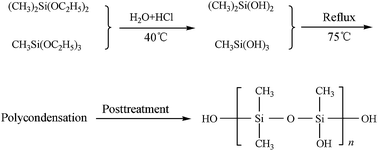Abstract:Hydroxyl-polysiloxane prepolymers were prepared via refluxing methyltriethoxysilane (METS) and dimethoxydimethylsilane (MSDS) at 75 degrees C in the presence of hydrochloric acid as the reactant. As-obtained prepolymers were used to modify aluminum chromium phosphate binder; and the modified aluminum chromium phosphate binder was adopted to fabricate bonded solid lubricating coatings with MoS2 and Sb2O3 as the solid lubricants. The structure of the modified aluminum chromium phosphate binder was investigated by infrared spectrometry and X-ray photoelectron spectroscopy. The corrosion behavior of the organosiloxane-modified phosphate solid lubricating coatings was examined by salt spray test. Moreover, an MM-200 friction and wear tester and an Optimol SRV-IV oscillating friction and wear tester were performed to evaluate the tribological behavior of the solid lubricating coatings at room temperature and 500 degrees C. The worn surfaces of the solid lubricating coatings were observed and analyzed with a scanning electron microscope. It was found that P-O-Si bond was formed in the organosiloxane-modified aluminum chromium phosphate binder, which confirmed that there occurs chemical reaction between hydroxyl-polysiloxane prepolymer and the aluminum chromium phosphate binder. As a result, the flexible organic structure bonded in the aluminum chromium phosphate binder favored to improve the toughness, corrosion resistance and tribological behavior of the molybdenum disulfide bonded solid lubricating coatings.
Key words:ALUMINUM-CHROMIUM-PHOSPHATES; FILMS; COMPOSITE; WEAR; MICROSTRUCTURE; FABRICATION; CHEMISTRY; MECHANISM; CONTACT; SPECTRA

Published in RSC Adv.,2015,5, 69606-69615 DOI: 10.1039/C5RA08727A


